Abocom Systems WUG2700 802.11b/g Mini Wireless LAN USB 2.0 Adapter User Manual Manual
Abocom Systems Inc 802.11b/g Mini Wireless LAN USB 2.0 Adapter Manual
Manual
802.11b/g USB Wireless LAN
Card
User’s Manual

REGULATORY STATEMENTS
FCC Certification
The United States Federal Communication Commission (FCC) and the
Canadian Department of Communications have established certain
rules governing the use of electronic equipment.
※ The 802.11b/g USB Wireless LAN Card has been tested to the
FCC exposure requirements (Specific Absorption Rate) measured
value of 0.076 watts/kg.
Part15, Class B
Warning: Changes or modifications to this unit not expressly approved
by the party responsible for compliance could void the user authority to
operate the equipment.
This device complies with Part 15 of the FCC Rules. Operation is
subject to the following two conditions:
(1) this device may not cause harmful interference, and
(2) this device must accept any interference received, including
interference that may cause undesired operation.
This equipment has been tested and found to comply with the limits for
a Class B digital device, pursuant to Part 15 of the FCC Rules. These
limits are designed to provide reasonable protection against harmful
interference in a residential installation. This equipment generates, uses
and can radiate radio frequency energy, and if not installed and used in
accordance with the instructions, may cause harmful interference to
radio communications. However, there is no guarantee that interference
will not occur in a particular installation. If this equipment does cause
harmful interference to radio or television reception, which can be
determined by turning off and on, the user is encouraged to try to
correct the interference by one or more of the following measures:
※ Reorient or relocate the receiving antenna.
※ Increase the distance between the equipment and receiver.
※ Connect the equipment into an outlet on a circuit different from that
to which the receiver is connected.
CAUTION:
This transmitter must not be co-located or operating in conjunction
with any other antenna or transmitter.
The equipment complies with FCC RF radiation exposure limits set
forth for an uncontrolled environment, under 47 CFR 2.1093 paragraph
(d)(2).
If you have any troble with use this equipment, please contact customer care service:
Company Name: Xterasys Corporation
Address: 4711 CHINO AVE. CHINO, CA91710 USA
Tel: 909-590-0600 / Fax: 909-590-0388
Contact Person: Mr. Larry
Table of Contents
INTRODUCTION ...................................................................................................1
FEATURES ..............................................................................................................1
SOFTWARE INSTALLATION.............................................................................2
INSTALL THE DRIVER & UTILITY ............................................................................2
HARDWARE INSTALLATION............................................................................5
NETWORK CONNECTION .................................................................................7
IN WINDOWS 98SE/ME..........................................................................................7
IN WINDOWS 2000/XP .........................................................................................10
IP ADDRESS .........................................................................................................12
Configuration Utility.............................................................................................13
PROFILE ...............................................................................................................14
LINK STATUS........................................................................................................15
SITE SURVEY........................................................................................................16
STATISTICS...........................................................................................................17
ADVANCED ..........................................................................................................19
ABOUT .................................................................................................................20
UNINSTALLATION.............................................................................................21

- 1 -
INTRODUCTION
The 802.11b+g Wireless LAN USB Adapter is designed for a USB type A port
of a laptop or desktop computer for creating a wireless workstation. It is USB 2.0
compliant which connects to any available USB port on a notebook or desktop
computer.
The 802.11b+g Wireless LAN USB Adapter complies with IEEE 802.11g
standard that offers a data rate up to 54Mbps in a wireless LAN environment. It is
backward compliant with IEEE 802.11b specification. The high-speed wireless
network card can plug into your notebook or desktop PC and accesses to
the LAN or peer-to-peer networking easily without wires or cables.
Whether you’re at your desk or in the boardroom, it allows you to share
printers, files, and other network resources.
Features
Complies with IEEE 802.11g standard for 2.4GHz Wireless LAN
USB 2.0 compliant
USB Plug & Play
Interoperable with existing network infrastructure
Secure information transmission
Freedom to roam while staying connected
Compatible with specialty wireless products and services
Up to 54 Mbps data rate
Antenna is built in the card with LED indication
Low power consumption
Easy to install and configure
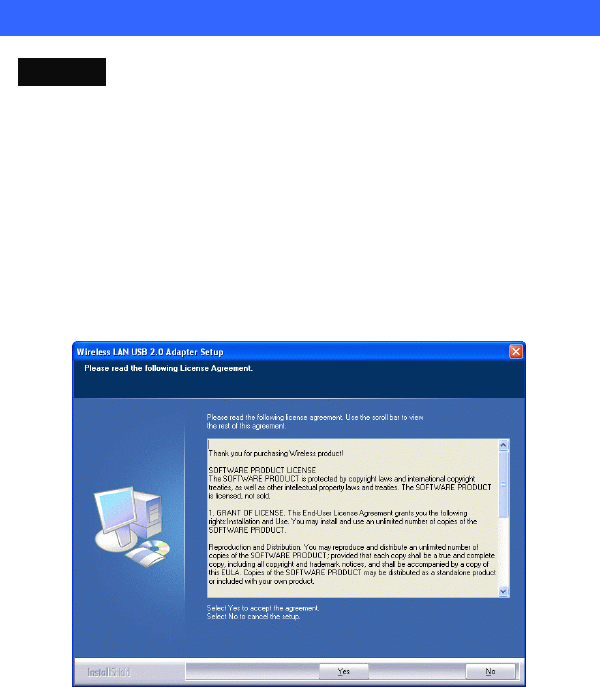
- 2 -
SOFTWARE INSTALLATION
Install the Driver & Utility
Caution!
Do not insert the wireless LAN adapter into your computer until the
procedures in “ Install the Driver& Utility” have been performed.
1. Exit all Windows programs. Insert the included CD-ROM into your
computer. The CD-ROM will run automatically.
2. When the Main Menu screen appears, click “ Driver & Utility
Installation” to continue.
3. When the License Agreement screen appears, please read the
contents and then click Yes to continue.
4. Select the check box to choose a configuration Tool from the listed
two choices.
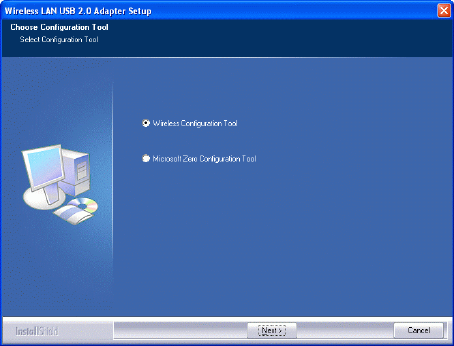
- 3 -
Wireless Configuration Tool: Choose to use our configuration
utility.
Microsoft Zero Configuration Tool: Choose to use Windows XP’s
built-in Zero Configuration Utility (ZCU).
Click Next to continue.
5. There are two modes for you to choose in this screen, either choose WiFi
mode or performance mode (TxBurst mode). This mode selection screen is
set for the default mode shown in the utility screen, you can still change its
mode later in the utility screen. Click Next to continue.
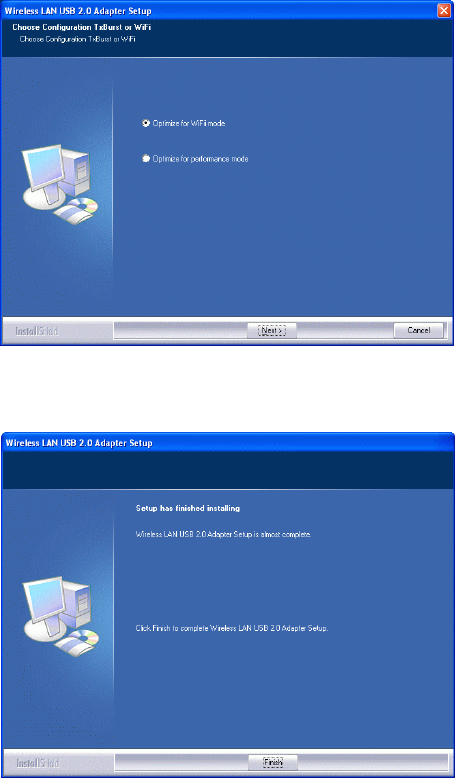
- 4 -
6. When the following screen appears, click Finish to complete the software
installation.

- 5 -
HARDWARE INSTALLATION
Note: Before you install the device to your computer, make sure you
have installed the driver and utility as described in the previous
section.
Windows 98SE/2000/ME / XP
1. Locate your USB host and insert the USB Adapter.
2. Once the device has been inserted to your computer, Windows will
detect the new hardware.
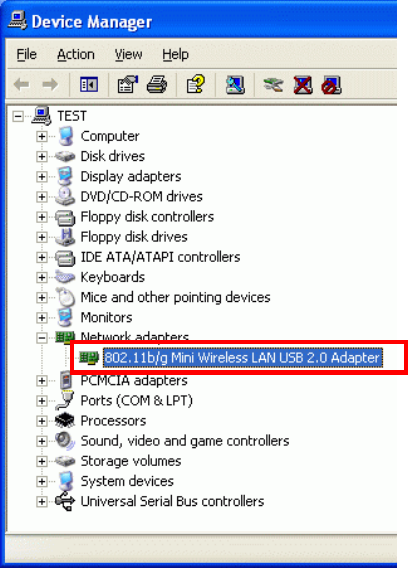
- 6 -
Verify
To verify if the device exists in your computer and is enabled, go to Start
Settings Control Panel System ( Hardware) Device Manager.
Expand the Network Adapters category. If the 802.11b/g Mini Wireless LAN
USB 2.0 Adapter is listed here, it means that your device is properly installed and
enabled.
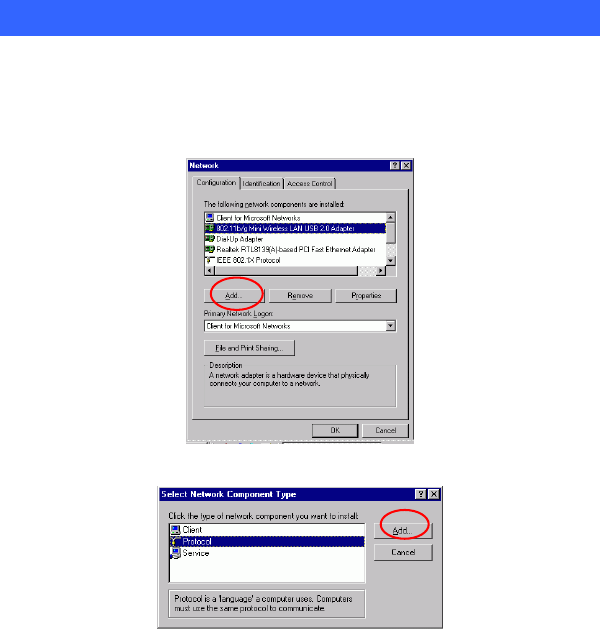
- 7 -
NETWORK CONNECTION
Once the device driver is well installed, a network setting described in the
following should be also established.
In Windows 98SE/ME
1. Go to Start Settings Control Panel Network.
2. Make sure that all the required components are installed. If any
components are missing, click on the Add button to add them
in.

- 8 -
3. For making your computer visible on the network, enable the File
and Print Sharing.
4. Click the Identification tab. Make up a name that is unique from the
other computers' names on the network. Type the name of your
workgroup, which should be the same used by all of the other PCs on
the network.
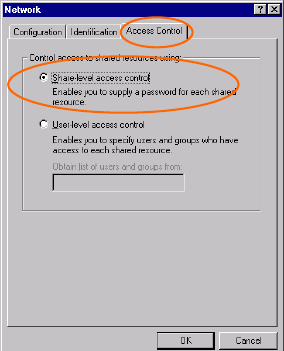
- 9 -
5. Click the Access Control tab. Make sure that “Share-level access
control” is selected. If connecting to a Netware server, share level
can be set to “User-level access control.”
6. When finished, restart your computer to activate the new device.
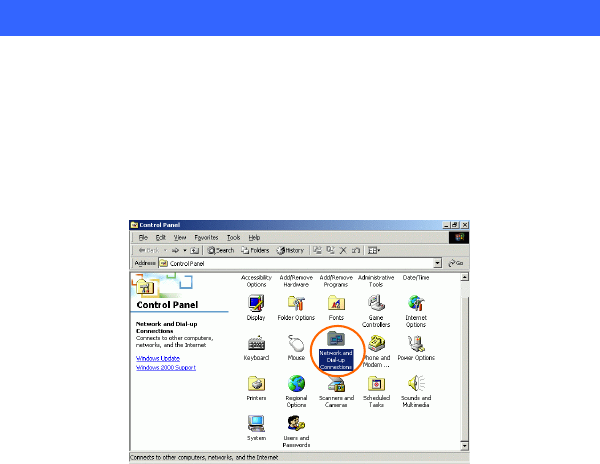
- 10 -
In Windows 2000/XP
1. (In Windows 2000)
Go to Start Settings Control Panel Network and Dial-up
Connections Local Area Connection Properties.
(In Windows XP)
Go to Start Control Panel Network and Internet Connections
Network Connection Wireless Network Connection Properties.
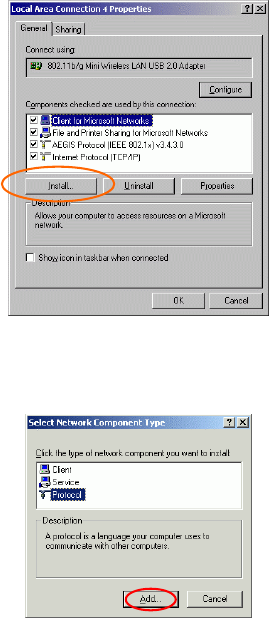
- 11 -
2. Make sure that all the required components are installed.
3. If any components are missing, click on the Install… button to
select the Client/Service/Protocol required. After selecting the
component you need, click Add… to add it in.
4. For making your computer visible on the network, make sure you
have installed File and Printer Sharing for Microsoft Networks.
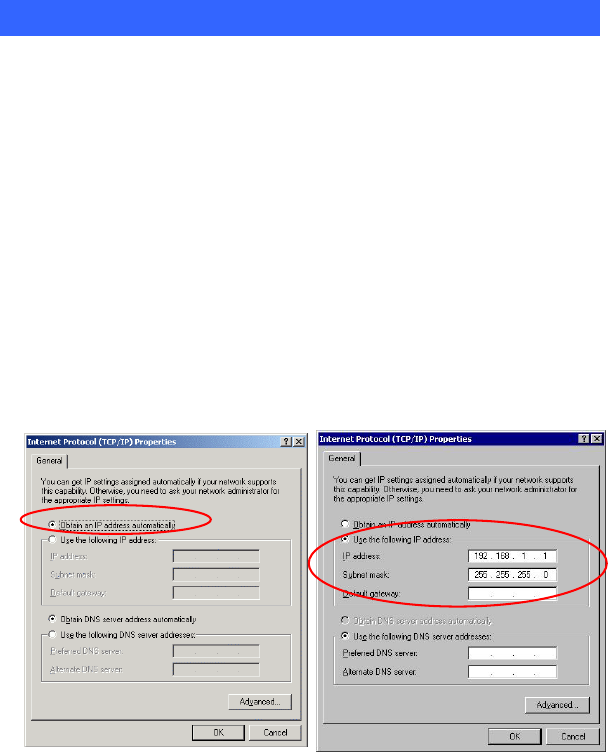
- 12 -
IP Address
Note: When assigning IP Addresses to the computers on the network, remember
to have the IP address for each computer set on the same subnet mask. If your
Broadband Router use DHCP technology, however, it won’t be necessary for you
to assign Static IP Address for your computer.
1. To configure a dynamic IP address (i.e. if your broadband Router has the DHCP
technology), check the Obtain an IP Address Automatically option.
2. To configure a fixed IP address (if you broadband Router is not DHCP
supported, or when you need to assign a static IP address), check the Use the
following IP address option. Then, enter an IP address into the empty field, for
example, enter 192.168.1.1 in the IP address field, and 255.255.255.0 for the
Subnet Mask.
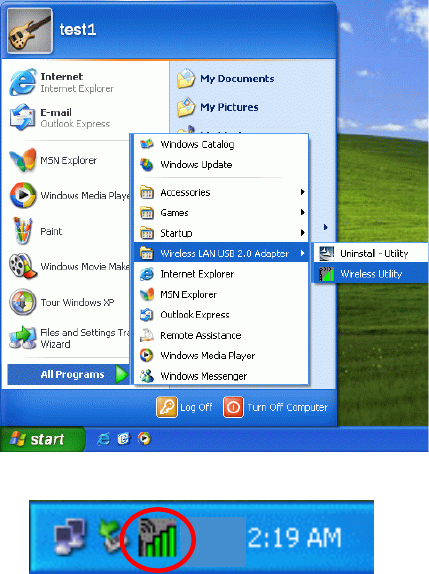
- 13 -
Configuration Utility
After the Wireless adapter has been successfully installed, users can use the
included Configuration Utility to set their preference.
Go to StartJ ProgramJWireless LAN USB 2.0 AdapterJ Wireless Utility
You can also open the Configuration Utility by clicking the icon.
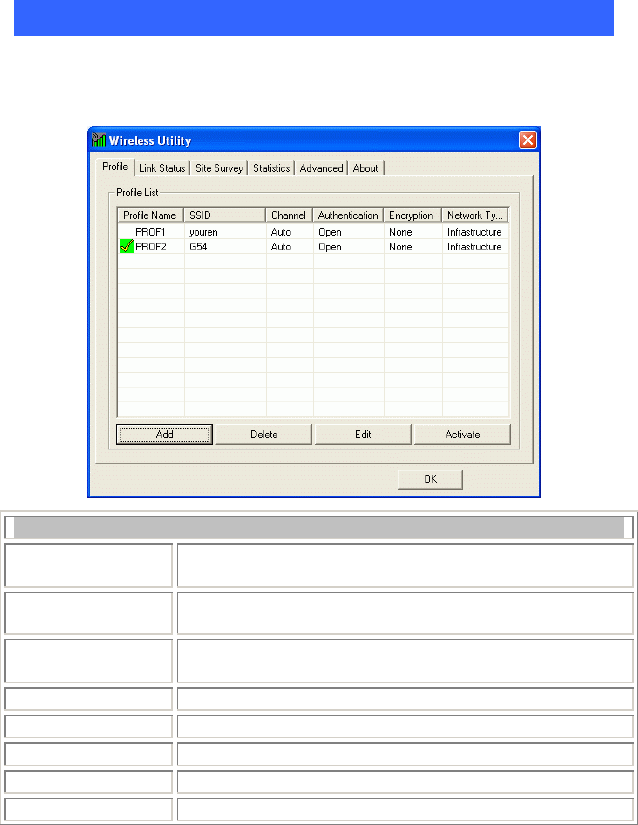
- 14 -
Profile
The Profile Manager enables you to create, edit and delete the profiles that the station uses
to connect to WLAN networks, to activate and de-activate profiles, and to raise and lower a
profiles’s priority.
Profile Tab
Profile Name You may enter a distinctive name of profile in this column.
The default is PROF# (# 1, #2, #3....)
SSID The SSID is the unique name shared among all points in
your wireless network.
Channel Shows the selected channel that is currently in use. (There
are 14 channels available, depending on the country.)
Authentication Shows the authentication mode of the device.
Encryption Shows the encryption mode of the device.
Network Type Shows the network type of the device.
Add Click to add a profile.
Delete Click to delete an existing profile.
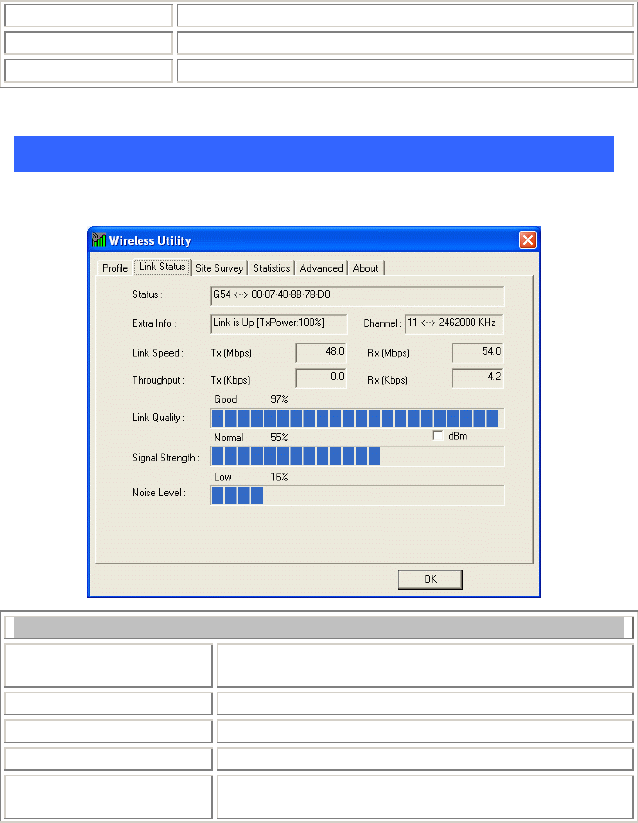
- 15 -
Edit Click to edit a profile.
Activate Click to make a connection between devices.
OK Click to exit this page.
Link Status
The link status page displays the detail information of current connection.
Link Status Tab
Status Shows the current connection status. If there is no
connection existing, it will show Disconnected.
Extra Info Shows the link status.
Channel Shows the current channel in use.
Link Speed Shows the current transmitting rate and receiving rate.
Throughput Shows the transmitting and receiving throughput in
the unit of K bits/sec.
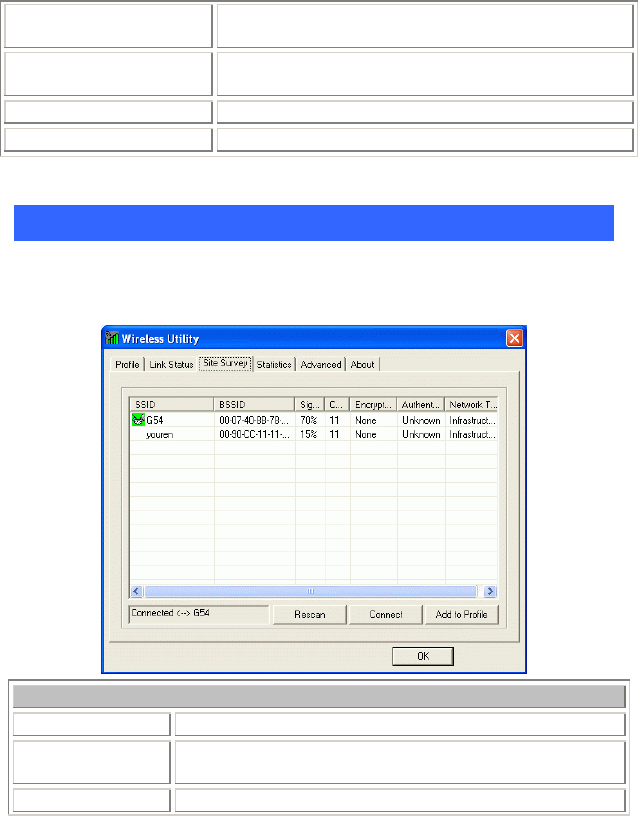
- 16 -
Link Quality Shows the connection quality based on signal strength
and TX/RX packet error rate.
Signal Strength Shows the Receiving signal strength, you can choose
to display as percentage or dBm format.
Noise Level Shows the noise signal strength.
OK Click to exit this page.
Site Survey
The Site Survey page displays the information of surrounding APs from last scan
result. List information including SSID, BSSID, Signal, Channel, Encryption
algorithm, and Network type.
Site Survey
SSID Shows the name of BSS of IBSS network.
BSSID Shows the MAC address of the AP or randomly generated of
IBSS.
Signal Shows the receiving signal strength of specified network.
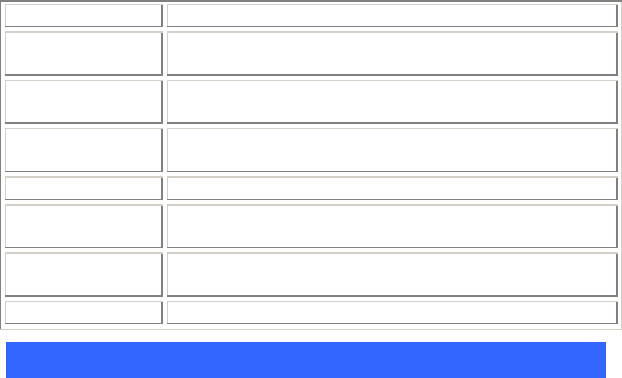
- 17 -
Channel Shows the currently used channel.
Encryption Shows the encryption type currently in use. Valid value
includes WEP, TKIP, AES, and Not Use.
Authentication Authentication mode used within the network, including
Unknown, WPA-PSK, WPA2-PSK, WPA and WPA2.
Network Type Network type in use, Infrastructure for BSS, Ad-Hoc for
IBSS network.
Rescan Click to refresh the site survey list.
Connect Select an item on the list and then click to make a
connection.
Add to Profile Select an item on the list and then click to add it into the
Profile list.
OK Click to exit this page.
Statistics
Statistics page displays the detail counter information based on 802.11 MIB
counters. This page translates that MIB counters into a format easier for user to
understand.
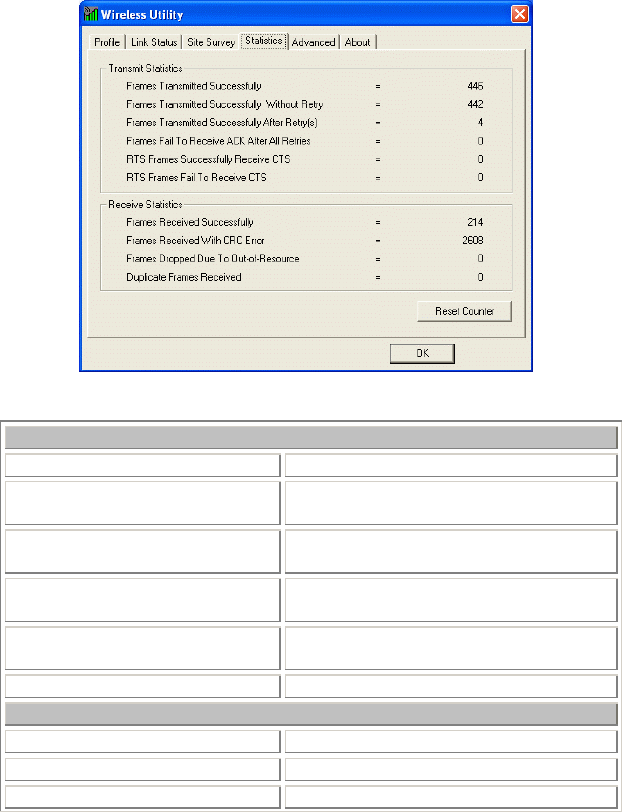
- 18 -
Transmit Statistics
Frames Transmitted Successfully Frames successfully sent.
Frames Transmitted Successfully
Without Retry
Frames successfully sent without any retry.
Frames Transmitted Successfully
After Retry
Frames successfully sent with one or more
reties.
Frames Fail To Receive ACK After
All Retries
Frames failed transmit after hitting retry
limit.
RTS Frames Successfully Receive
CTS
Successfully receive CTS after sending RTS
frame
RTS Frames Fail To Receive CTS Failed to receive CTS after sending RTS.
Receive Statistics
Frames Received Successfully Frames Received Successfully
Frames Received With CRC Error Frames received with CRC error.
Frames Dro
pp
ed Due To Frames dropped due to resource issue
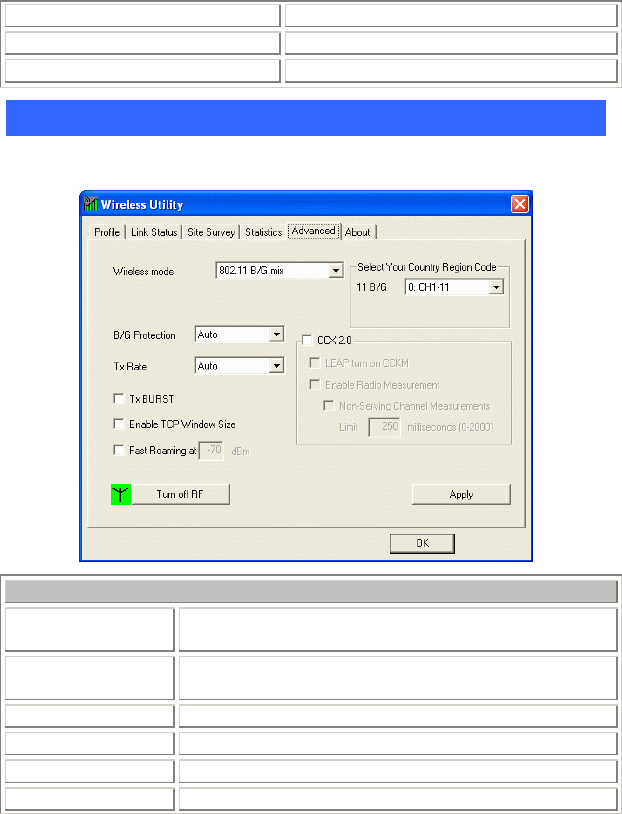
- 19 -
Out-of-Resource
Duplicate Frames Received Duplicate received frames.
Reset Counter Reset counters to zero.
Advanced
This Advanced page provides advanced settings.
Advanced Tab
Wireless mode Select wireless mode. 802.11b only and 802.11 b/g mixed
mode are supported
Ad hoc wireless mode Select ad hoc wireless mode. 802.11b only and 802.11 b/g
mixed mode are supported.
11B/G Protection Choose Auto, On or Off from the pull-down menu.
Auto STA will dynamically change as AP announcement
On Always send frame with protection.
Off Always send frame without protection.
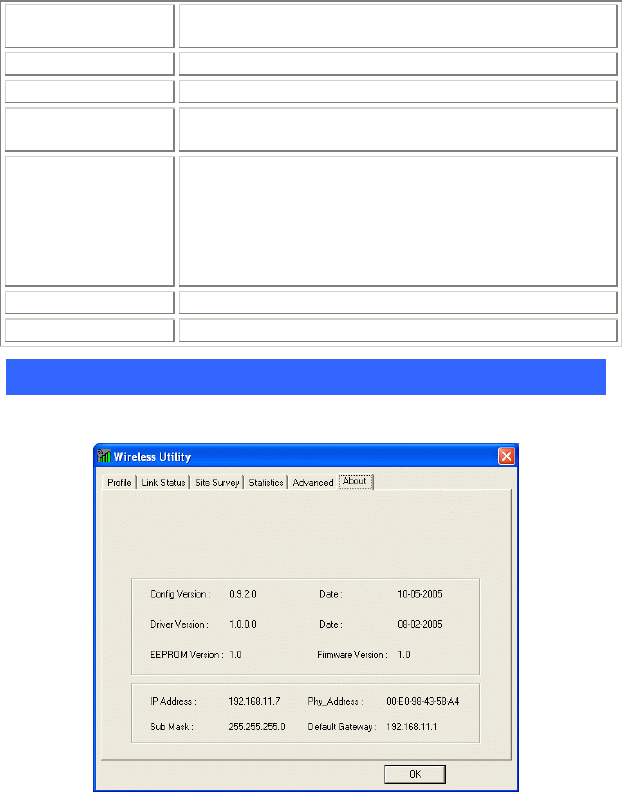
- 20 -
TX Rate Select the Tx rate from the pull-sown menu. The default is
auto.
Tx Burst Check to enable the burst mode.
Fast Roaming at Check to set the roaming interval.
Select Your Country
Region Code
Select your country region code from the pull-down menu.
CCX2.0: support
Cisco Compatible
Extensions function:
Check to enable the CCX2.0 function.
• LEAP turn on CCKM
• Enable Radio Measurement: can channel measurement
every 0~2000 milliseconds.
• Enable QOS: enable Quality of Service.
Turn radio ON/OFF for FAA requirement.
Radio Off/On Click to turn off the radio function.
Apply Click to apply the above settings.
About
About page display the wireless card and driver version information
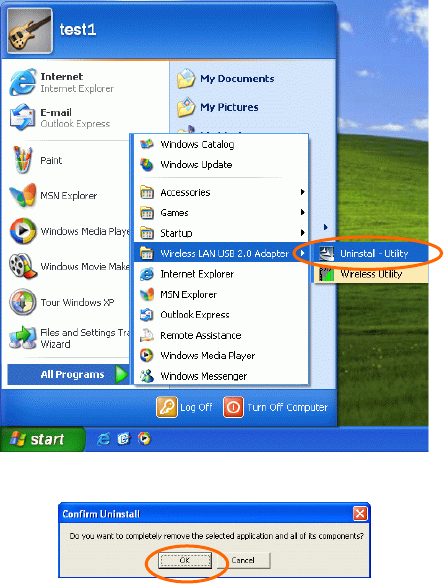
- 21 -
UNINSTALLATION
In case you need to uninstall the Utility and driver, please refer to below steps.
(As you uninstall the utility, the driver will be uninstalled as well.)
1. Go to Start Programs Wireless LAN USB 2.0 Adapter
Uninstall - Utility.
2. Click OK to continue.
3. Click Finish to complete the uninstalled procedure.